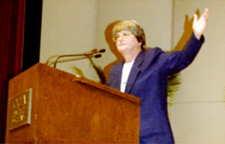The audience in a packed Roussel Hall sat spellbound Tuesday night as three death penalty opponents told their stories.
Sister Helen Prejean C.S.J. wrote “Dead Man Walking,” a book which was made into an Oscar-winning movie. Denise LeBoeuf is a defense attorney who specializes in saving her clients from execution, and Ray Krone is an exonerated death row inmate.
All three of the activists came to their truth about the death penalty differently and somewhat grudgingly.
Prejean said that working with poor people in New Orleans’ St. Thomas housing project in the early 1980s and corresponding with death row inmate Patrick Sonnier made her aware of a process that seemed to plague poor black people in the South.
“Poor people get the death penalty because they don’t have resources,” she said.
Prejean also stressed that the death penalty is almost never used in northern states, and even in the South capital punishment occurs at a much higher rate in cases of offenders of black-on-white murders than black-on-black murders.
LeBoeuf began working with death row inmates in Louisiana soon after she graduated from law school.
Her clients did not seek her out because of her expert knowledge of law, but because few lawyers will take capital cases, she said.
“People were coming to me and saying take this case, I have no one else,” said LeBoeuf.
Like Prejean, LeBoeuf saw patterns among death row inmates. “The death penalty is about racism, poverty and tremendous, untreated child-abuse,” she said.
In case after case, LeBoeuf said she was drawn into a vast world of injustices in the political system. One example was an attorney who, having committed a crime, had been sentenced by the court to public service – acting as a defense attorney in a capital case he was not qualified to handle.
Krone, 45, was released from Arizona’s state prison on April 8, 2002. He spent 10 years behind bars for a crime that he did not commit.
It was only after Krone’s story was on the front page of The Arizona Republic that the prosecution conceded it had erred and Krone was released.
Prior to the media publicity, other seemingly indisputable defenses, such as DNA evidence that did not match Krone’s DNA, were futile. Krone’s fate appeared to be sealed. After two appeals that brought his case all the way to the Arizona Supreme Court, a judge still gave him 25 years to life.
What Krone, LeBoeuf, and Prejean all seemed to emphasize is that the stories that they were sharing were not the strange fluke exceptions that can occasionally occur, but that the injustices they spoke of happen to many people across the country.
Krone’s release made him the 100th person to be released from death row due to a wrongful conviction.
LeBoeuf describes the work she does as “sitting in people’s kitchens and having them tell their stories.”
Prejean chronicled her journey through the criminal justice system and her own spiritual life with her best-selling book, which was nominated for a Pulitzer Prize in 1993, and in 1996 gained increased popularity when it was made into a movie starring Susan Sarandon and Sean Penn.
The book now is part of the Loyola’s freshman reading program. It aims to help provide what university president, the Rev. Bernard Knoth S.J., calls a holistic education, or education of the whole self.
“This is about an education that deals with the heart and deals with values,” Knoth told the audience before the presentation.
The desire to expose students to larger world outside of their own and outside of the classroom was echoed by Provost Walter Harris, the university vice-president, who told the group that the university wants to move students toward critical thinking skills and social justice.
Krone, LeBoeuf and Prejean all echoed the same theme of challenging the students to be part of being part of something larger than themselves.
Krone told the students that on the day he was released, he was asked by reporters about how he felt about a God who had left him in prison for 10 years.
Not yet ready for such a philosophical question, Krone gave the question a moment of thought and told the reporter, “It was not about the 10 years spent in prison, but about preparing for the next 10 years.”






